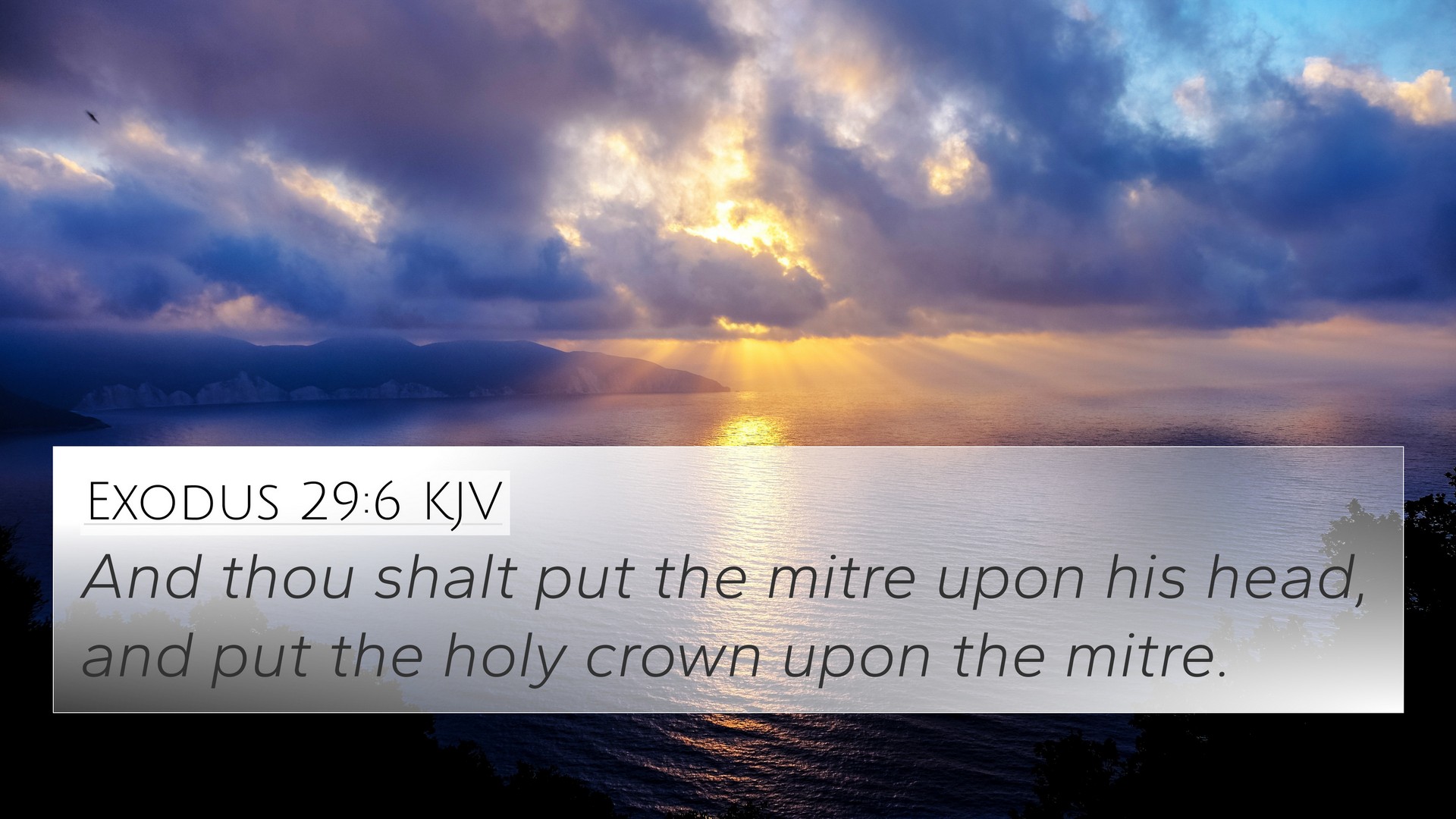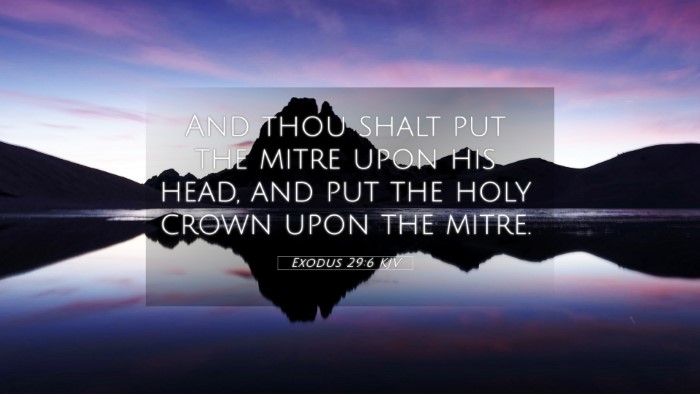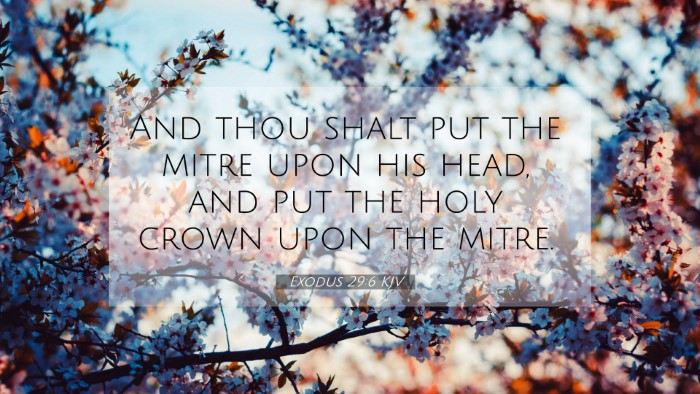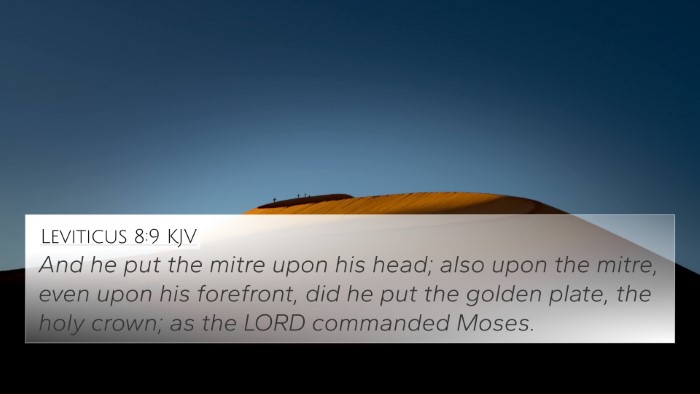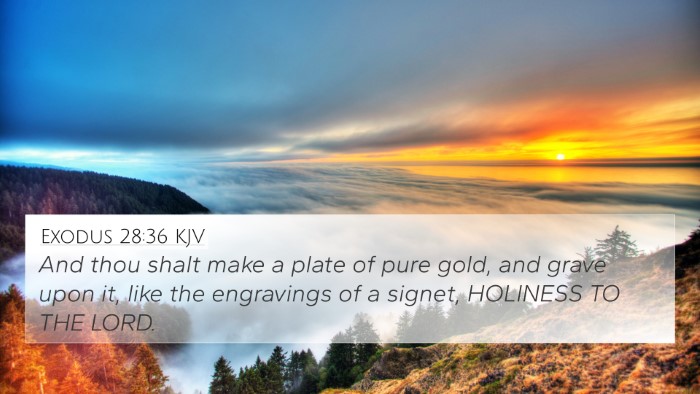Understanding Exodus 29:6
Verse Context: Exodus 29:6 states: "And thou shalt put the mitre upon his head, and put the holy crown upon the mitre." This verse is part of the instructions given to Moses regarding the consecration of Aaron and his sons as priests. The mitre referred to is the distinctive headgear worn by the high priest, symbolizing dignity, authority, and the holy office they were to hold.
Summary of Interpretations
This passage is rich in symbolism and significance. The act of dressing the priest properly underscores the gravity and sanctity of the priestly office. The combination of the mitre and the holy crown symbolizes the acknowledgment of God's authority, the leadership role of the priesthood, and the connection between heaven and earth through their ministry.
Commentary Insights
- Matthew Henry: Henry emphasizes the importance of holiness in the office of the priest and how the attire was not merely for physical appearance but served as a means to highlight the spiritual responsibilities. He notes that the priest's head being adorned represents a connection to God and the divine purpose in their service.
- Adam Clarke: Clarke provides insights on the materials and designs of the mitre, suggesting that these elements reflect the splendor of God's presence. He asserts that the mitre and crown play pivotal roles in linking the theological significance of the priest's calling with their duties to lead the people in worship and service toward God.
- Albert Barnes: Barnes discusses the symbolic nature of the holy crown, interpreting it as a representation of the authority granted by God. He correlates this authority to the idea that the priests were to act as mediators between God and the Israelites, bearing the weight of the congregation's sins and interceding on their behalf.
Thematic Connections
This verse can be connected to various other passages in the Bible that highlight the themes of priesthood, holiness, and divine authority. Here are some significant cross-references:
- Exodus 28:4 - "And these are the garments which they shall make; a breastplate, and an ephod, and a robe, and a broidered coat, a mitre, and a girdle."
- Leviticus 8:6-9 - "And Moses brought Aaron and his sons, and washed them with water. And he put upon him the coat, and girded him with the girdle..."
- Hebrews 5:4 - "And no man taketh this honour unto himself, but he that is called of God, as was Aaron."
- 1 Peter 2:9 - "But ye are a chosen generation, a royal priesthood, an holy nation..."
- Revelation 1:6 - "And hath made us kings and priests unto God and his Father..."
- Matthew 27:51 - "And, behold, the veil of the temple was rent in twain from the top to the bottom..."
- Romans 12:1 - "I beseech you therefore, brethren, by the mercies of God, that ye present your bodies a living sacrifice, holy, acceptable unto God..."
- James 4:10 - "Humble yourselves in the sight of the Lord, and he shall lift you up."
- Hebrews 10:19-22 - "Having therefore, brethren, boldness to enter into the holiest by the blood of Jesus..."
Inter-Biblical Dialogue
This verse can be examined through the lens of its implications for both Old and New Testament understandings of priesthood and sacrifice. The linkage between Exodus and the later developments in the New Testament concerning Christ's role as our high priest fosters deep theological reflection on God's continual plan for redemption.
The Importance of Cross-Referencing
Utilizing a Bible Concordance or Cross-Reference Bible Study Guide can help in finding additional connections and deeper insights. Understanding how the themes of Exodus 29:6 resonate throughout scripture can enhance one’s comprehension and application of biblical principles in life.
Conclusion
Exodus 29:6 serves as a pivotal highlight in understanding the significance of the priesthood in the Old Testament and its fulfillment in Jesus Christ. Engaging in Comparative Bible Verse Analysis allows for enriching insights concerning the role of God's chosen leaders, the symbols they bear, and the continuous dialogue between the Old and New Testaments. This verse not only instructs in ancient rites but also speaks volumes about the modern-day call to holiness and service to God.
